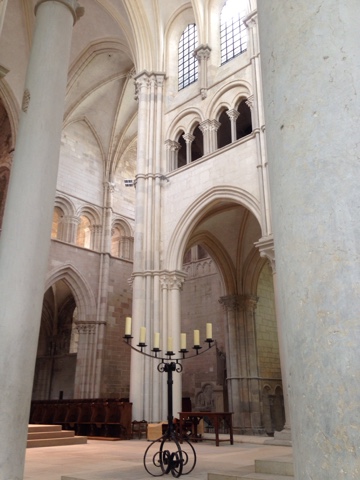The picturesque village of Vezelay is built along a ridge among the northern foothills of the Morvan countryside. The basilica of Vezelay became one of France's great pilgrimage destinations.
It was here that St. Bernard, the great Cistercian abbot, preached sermon that launched the Second Crusade in 1146. The throngs of barons and clergy from all over Europe who gathered at Vezelay was enormous.
Although the Second Crusade was a disaster, Vezelay remained one of the major starting points of pilgrimage roads. In 1190, Philip Augustus, king of France, and Richard the Lion-Hearted met here to set aside their differences and unite on the Third Crusade.
Vezelay is one of the finest monuments in the Romanesque style.
In the dimly lit narthex is the marvelous tympanum of the central doorway. Dating from 1125 (and thus preceding the one at Autun), it shows Christ of superhuman size, blessing the twelve apostles before sending them out into the world. The sculptor's great talent shows in the masterly handling of the folds of Christ's robes as well as the treatment of the Apostles and the depiction of the signs of
the Zodiac, etc.
The 'Mission of the Apostles' (described above) was a highly original subject. Many of the principal Romanesque tympanum sculptures depict the Last Judgment.
The subject is from the Acts of the Apostles which instructed the apostles to be witnesses to the resurrection.
Ok, art history majors, here we go:
A cloud is shown by the sculptor and the figure of Jesus is assumed into heaven surrounded by a Mandela, an almond-shaped halo that indicates his ascension; the apostles flank him. From Christ's hands, rays of the Holy Spirit descend into the heads of the apostles.
A myriad group of striking figures represent the people to whom the apostles will bear the Gospel. These fugures are based on the imaginative descriptions of travelers to distant lands. For instance, in the compartment to the right of Christ's head are the "pig-shouted Ethiopians" described in one pilgrim's report.
Vezelay's basilica capitals depict Biblical scenes, the lives of saints, and weird beasts with great imagination which anticipates subsequent work at Aurun.
On a sign inside I read this:
"Welcome! The basilica of Vezelay, a masterpiece of medieval art and an epitome of Christian faith and history, offers welcome to everyone, especially to pilgrims and to all those who are searching for inner peace."
The most important pilgrimage site in the 11th and 12th centuries was Santiago de Campostela in the northwest corner of Spain. There were four major pilgrimage roads to Santiago; they began in Paris, LePuy, Arles, and Vezelay.






















No comments:
Post a Comment